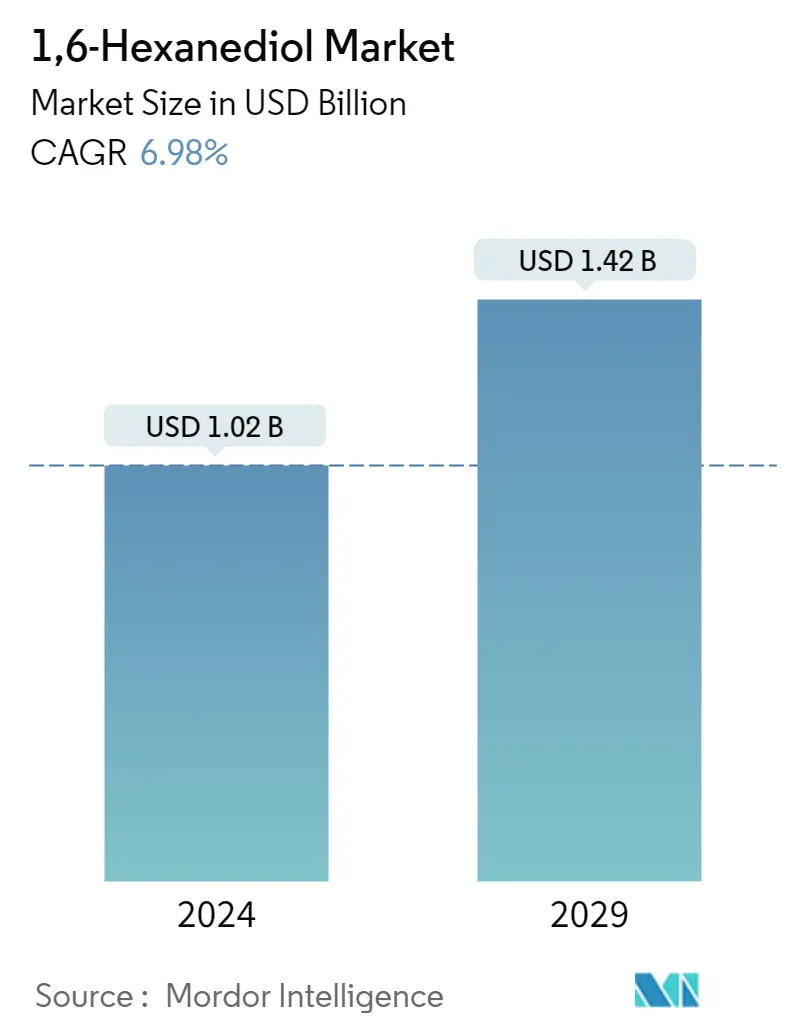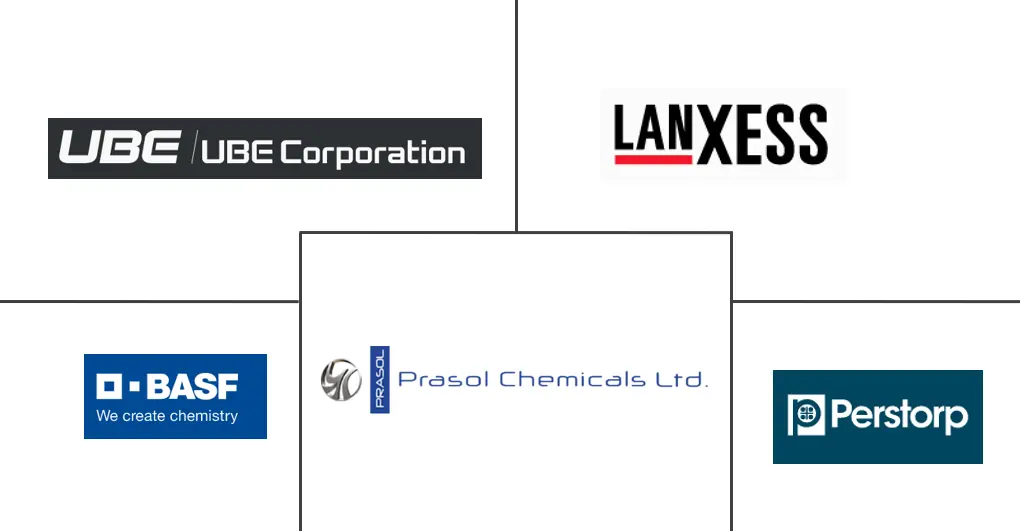Market Size of 1,6-Hexanediol Industry

| Study Period | 2019 - 2029 |
| Market Size (2024) | USD 1.02 Billion |
| Market Size (2029) | USD 1.42 Billion |
| CAGR (2024 - 2029) | 6.98 % |
| Fastest Growing Market | Asia Pacific |
| Largest Market | Europe |
Major Players
*Disclaimer: Major Players sorted in no particular order |
1,6-Hexanediol Market Analysis
The 1,6-Hexanediol Market size is estimated at USD 1.02 billion in 2024, and is expected to reach USD 1.42 billion by 2029, growing at a CAGR of 6.98% during the forecast period (2024-2029).
The Covid-19 outbreak had a negative impact on various industries including the construction industry where 1,6-Hexanediol is used in the coatings. This has a negative impact on the market. However, in 2021 and 2022, the market has gained momentum which has led to pre-pandemic demand for 1,6-Hexanediol.
- Major factors driving the market studied are the increasing usage as feedstock for manufacturing chemical compounds and rising demand from the wind energy sector.
- On the other side, the availability of substitutes such as butanediol and pentanediol is hindering the growth of the market.
- Advancement in technology and the development of bio-based raw materials is expected to provide new opportunities for the 1,6-Hexanediol market.
- Europe region represents the largest market owing to the consumption from countries such as Germany and the United Kingdom.
1,6-Hexanediol Industry Segmentation
The 1,6-Hexanediol is widely used in the production of industrial polyester and polyurethane. It helps in improving the hardness and flexibility of polyesters. The 1,6-Hexanediol market is segmented by raw material, application, and geography. By raw material, the market is segmented into cyclohexane and adipic acid. By application, the market is segmented into polyurethane, coatings, acrylates, adhesives, polyester resins, plasticizers, and others. The report also covers the market size and forecasts for the 1,6-hexanediol market in 15 countries across major regions. For each segment, the market sizing and forecasts have been done on the basis of revenue (USD).
| Raw Material | |
| Cyclohexane | |
| Adipic Acid |
| Application | |
| Polyurethane | |
| Coatings | |
| Acrylates | |
| Adhesives | |
| Polyester Resins | |
| Plasticizers | |
| Others |
| Geography | |||||||
| |||||||
| |||||||
| |||||||
| |||||||
|
1,6-Hexanediol Market Size Summary
The 1,6-Hexanediol market is poised for significant growth over the forecast period, driven by its increasing application as a feedstock in the production of chemical compounds and the rising demand from the wind energy sector. Despite the initial setbacks caused by the Covid-19 pandemic, which negatively impacted industries like construction where 1,6-Hexanediol is used in coatings, the market has rebounded to pre-pandemic demand levels. The market's expansion is further supported by advancements in technology and the development of bio-based raw materials, which are expected to open new avenues for growth. However, the presence of substitutes such as butanediol and pentanediol poses a challenge to market expansion. Europe remains the largest market, with significant consumption in countries like Germany and the United Kingdom, while Asia-Pacific is the fastest-growing region due to steady demand from various manufacturing sectors.
The demand for polyurethanes, particularly in paint and coatings, elastomers, and foams, is a key driver for the 1,6-Hexanediol market. Its role as a chain extender in polyurethane applications enhances properties such as corrosion resistance, mechanical strength, and heat resistance. This demand is further bolstered by expansion projects in the paints, coatings, and adhesives sectors globally. Notable developments include TIGER Drylac's expansion in the United States and Pearl Polyurethane Systems' launch of a new adhesive in India. The construction industry's growth, particularly in the United States, is expected to further boost demand for 1,6-Hexanediol. The market is characterized by partial consolidation, with major players like BASF SE, LANXESS, and UBE Corporation leading the industry. Recent initiatives, such as LANXESS's sustainable production efforts and PETRONAS Chemicals Group's acquisition of Perstorp, highlight the ongoing strategic movements within the market.
1,6-Hexanediol Market Size - Table of Contents
-
1. MARKET DYNAMICS
-
1.1 Drivers
-
1.1.1 Increasing Usage as Feedstock for Manufacturing Chemical Compounds
-
1.1.2 Rising Demand from the Wind Energy Sector
-
1.1.3 Other Drivers
-
-
1.2 Restraints
-
1.2.1 Availability of Substitutes
-
1.2.2 Other Restraints
-
-
1.3 Industry Value Chain Analysis
-
1.4 Porter's Five Forces Analysis
-
1.4.1 Bargaining Power of Suppliers
-
1.4.2 Bargaining Power of Consumers
-
1.4.3 Threat of New Entrants
-
1.4.4 Threat of Substitute Products and Services
-
1.4.5 Degree of Competition
-
-
1.5 Price Trend Analysis
-
-
2. MARKET SEGMENTATION (Market Size in Value)
-
2.1 Raw Material
-
2.1.1 Cyclohexane
-
2.1.2 Adipic Acid
-
-
2.2 Application
-
2.2.1 Polyurethane
-
2.2.2 Coatings
-
2.2.3 Acrylates
-
2.2.4 Adhesives
-
2.2.5 Polyester Resins
-
2.2.6 Plasticizers
-
2.2.7 Others
-
-
2.3 Geography
-
2.3.1 Asia-Pacific
-
2.3.1.1 China
-
2.3.1.2 India
-
2.3.1.3 Japan
-
2.3.1.4 South Korea
-
2.3.1.5 Rest of Asia-Pacific
-
-
2.3.2 North America
-
2.3.2.1 United States
-
2.3.2.2 Canada
-
2.3.2.3 Mexico
-
-
2.3.3 Europe
-
2.3.3.1 Germany
-
2.3.3.2 United Kingdom
-
2.3.3.3 France
-
2.3.3.4 Italy
-
2.3.3.5 Rest of Europe
-
-
2.3.4 South America
-
2.3.4.1 Brazil
-
2.3.4.2 Argentina
-
2.3.4.3 Rest of South America
-
-
2.3.5 Middle-East and Africa
-
2.3.5.1 Saudi Arabia
-
2.3.5.2 South Africa
-
2.3.5.3 Rest of Middle-East and Africa
-
-
-
1,6-Hexanediol Market Size FAQs
How big is the 1,6-Hexanediol Market?
The 1,6-Hexanediol Market size is expected to reach USD 1.02 billion in 2024 and grow at a CAGR of 6.98% to reach USD 1.42 billion by 2029.
What is the current 1,6-Hexanediol Market size?
In 2024, the 1,6-Hexanediol Market size is expected to reach USD 1.02 billion.

